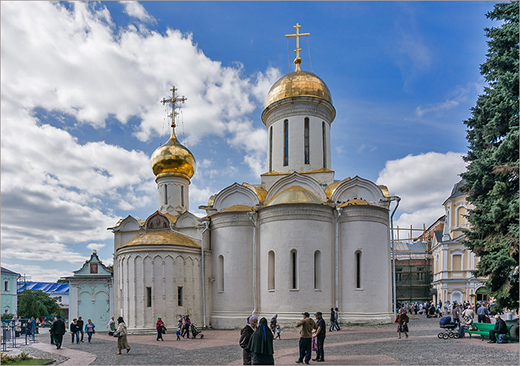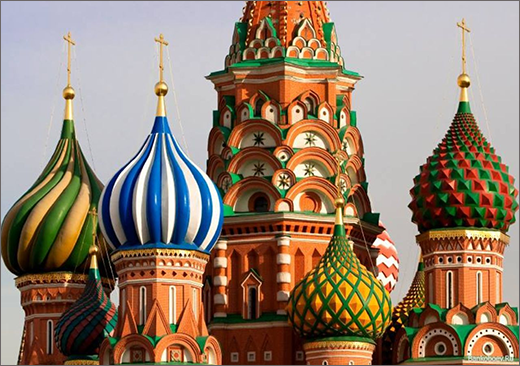Moscow Kremlin
The Moscow Kremlin is a magnificent architectural achievement. Its monumental walls and towers, golden-domed cathedrals, and ancient palaces stand high on the Borovitskiy Hill above the Moscow River. It's an entire city within Moscow. Russian princes and tsars lived here a long time ago, but today it is the official residence of the President of Russia.
Moscow Kremlin
What does the word 'Kremlin' mean?
Kremlin is the Russian word for “fortress” or “citadel”. Indeed, some other old Russian cities have their own Kremlin. But the Kremlin of Moscow is the one known around the world and the symbol of the Russian state.The word "Kremlin" meant not the outer city wall but a fortress within a city. Thus, in the first 200 years of Moscow history, people referred to the Moscow fortress as "the city." Later on, the town started to grow, and more people settled outside the city wall.

Moscow Kremlin wall, the Saviour tower
It was a common practice in the past to built a fortress in the middle of a town. Smolensk, Novgorod, Pskov, Astrakhan, Tobolsk, Kazan, Kolomna, Zaraisk, and many other Russian towns had their kremlins.
The History of Moscow Kremlin
The Kremlin dates back to the first residents of Moscow. The founder of Moscow, Prince Yury Dolgoruky, ordered the construction of the first wooden fortress in 1156 on a site known as the town of Moscow, but the word “kremlin” was only first recorded in the 14th century.The Kremlin we see today was constructed in the late 15th century. Moscow prince Ivan the Great dreamed of building a capital that would equal Constantinople in grandeur and importance. He called his dream the "Third Rome" and brought architects from Italy. Most of their work is still standing.

View of 17th-century Moscow Kremlin, Apollinary Vasnetsov
After the Revolution, the Bolsheviks moved the capital to Moscow and settled on the grounds of the Kremlin. Lenin, Stalin, and some members of the Soviet government lived on the territory of the Kremlin. Since Soviet times the word "kremlin" has become synonymous with "government of Russia".
Does anyone live in the Kremlin these days? In fact, yes and no. The president lives not in the Kremlin, but in his residence outside of Moscow. Kremlin serves only as an official place of work.
The Arsenal building houses the barracks of the Presidential Regiment, where the servicemen of the Presidential regiment live, however, this hardly makes the Kremlin residential. There are no classic "residential areas" where, for example, officials or just wealthy citizens would live on the territory of the fortress.
What to see in the Kremlin?
"The Kremlin deserved a journey to Moscow" is the truism penned by French traveler Marquis de Custine in the 19th century, and it is still relevant today. Don't miss your opportunity to book the tour of the Moscow Kremlin.
 While planning your visit you need to think of what would you like to see. You may book different types of tickets: Kremlin grounds with cathedrals, Armory Museum, Diamond Fund, Ivan the Great Bell Tower, Archeological exhibition.
While planning your visit you need to think of what would you like to see. You may book different types of tickets: Kremlin grounds with cathedrals, Armory Museum, Diamond Fund, Ivan the Great Bell Tower, Archeological exhibition.

Cathedral Square of Moscow Kremlin
Kremlin grounds
Did you know that Kremlin is the largest fortress in Europe? Walking around its vast territory of 28 hectares you’ll discover ancient churches, gardens, and unusual monuments. During your walk around the Kremlin Grounds, you will see:
 It's important to remember that a part of the Kremlin is not accessible and is occupied by the president's offices and the barracks of the president's regiment. You can admire Kremlin walls and towers only from the outside but climbing or walking along the Kremlin wall is not allowed.
It's important to remember that a part of the Kremlin is not accessible and is occupied by the president's offices and the barracks of the president's regiment. You can admire Kremlin walls and towers only from the outside but climbing or walking along the Kremlin wall is not allowed.
You may also visit two churches:

The Kremlin is closed on Thursdays.
The Kremlin grounds are open from 9:30 a.m. to 6 p.m in summer (May 15 to Sept 30) and from 1om am to 5 pm in the low season (Oct 1 to May 14).
The Armoury Museum is open from 10 a.m. to 6 p.m. with four sessions starting at 10 a.m., 12 p.m., 2:30 p.m., and 4:30 p.m.
Please note that a ticket purchased online or at the Kremlin ticket office doesn't allow you to explore Kremlin with a guide. If you are willing to have a guided tour of the Kremlin, we'll need to book a visit including permission to guide.
On average a visit to the Kremlin grounds lasts 1,5 hours. Armory museum tour lasts 1 - 2 hours.
- Cathedral Square with oldest Moscow churches
- Ivan the Great’s Bell Tower (outside only)
- Patriarch chamber museum with restored 17th-century interiors and a curious collection of patriarch's treasures
- Three main cathedrals of the late 15th - early 16th century and a Church of the Deposition of the Robe
- The biggest cannon in the world known as Tsar's cannon
- The biggest bell in the world referred to as Tsar's bell
- Peaceful Taynitsky Garden that offers impressive views on the Cathedral Square, Moscow River, and a helipad constructed for the use of Vladimir Putin. Here you can find an oak tree planted by Yuri Gagarin and
- The view (from outside!) on the presidential offices

Tsar's bell
Kremlin churches
Your ticket to the Kremlin grounds includes a visit to The Kremlin cathedrals. How many churches are in the Kremlin?

You can visit three 15th-16th century cathedrals.

Assumption Cathedral
You can visit three 15th-16th century cathedrals.
- The Assumption Cathedral (1479) was the main place of worship for Moscow and the place of coronation for all the Tsars.
- The gilded Cathedral of the Annunciation was a domestic royal church; it has several unique icons by Andrey Rublev.
- The Cathedral of the Archangel Michael is the final resting place of the first Russian princes and tsars. You can find tombs of the first Russian rulers.
You may also visit two churches:
- The Church of the Deposition of the Robe is a private church of the metropolitans and patriarchs. The church is surprisingly small and quiet. Among the interesting exhibits is a rare collection of wooden sculptures.
- The Church of the 12 Apostles is a part of the Patriarch's Chambers. Here you'll discover a gorgeous 17th-century iconostasis and a remarkable collection of icons.
The bell tower of Ivan the Great also had a church in the past but it was later converted into an exhibition hall.
Several churches are located inside the Grand Kremlin Palace. Walking around the cathedral square you'll discover beautiful golden domes of the Upper Saviour Cathedral.

Several churches are located inside the Grand Kremlin Palace. Walking around the cathedral square you'll discover beautiful golden domes of the Upper Saviour Cathedral.

Upper Saviour Cathedral
Other Museums in Moscow Kremlin
In addition to visiting the Kremlin grounds, you might also visit the following sights:
- The Armoury Museum is a royal treasury. Among the must-sees are 10 Faberge Easter Eggs, Royal crowns and thrones, Coronation dresses, and the second largest in the world collection of Royal carriages. The museum is open daily except for Thursday. You need to book your visit in advance and choose a convenient session: 10 am, 12 pm, 2.30 pm, or 4.30 pm. The visit lasts 1,5 hours, but sometimes they allow you to stay a bit longer.
- The Diamond Fund is a separate museum located in the same building as the Armoury. It boasts unique diamonds, rare precious stones, masterpieces of jewelry of the 18th-20th centuries, and gold and platinum nuggets. The museum is open daily except for Thursday from 10 am till 6 pm with a break from noon to 1 pm. You may book your visit online http://www.gokhran.ru/en/ however are they usually sold out quickly. You might also get tickets on the day of the tour; your chances depend on visitors' flow on the day of your visit. The museum is easy to navigate as they give you a free audio guide in English.
- The Grand Kremlin Palace is the Official Residence of the Russian Federation President, which is not open to the general public. On specific dates, we organize group tours of the palace. The palace interior is impressive: you can explore the luxurious ceremonial halls of St. George. St. Andrew, St. Vladimir, as well as ancient Terem Palace and Faceted Chamber.
- Ivan the Great bell tower offers amazing views of the Kremlin, but the tickets are not available in advance. You may purchase the ticket only on the day of your visit. The museum is open every day, except Thursday, with sessions at : 10:15, 11:15, 13:00, 14:00, 15:00, 16:00, 17:00 from May 15 to 30 September. Considering that the group size is limited to 5 people, your chances to visit the bell tower are not very high.

The Grand Kremlin Palace in Moscow Kremlin
Visiting the Kremlin
The Kremlin is included in our classic tours with our Moscow tour guide.The Kremlin is closed on Thursdays.
The Kremlin grounds are open from 9:30 a.m. to 6 p.m in summer (May 15 to Sept 30) and from 1om am to 5 pm in the low season (Oct 1 to May 14).
The Armoury Museum is open from 10 a.m. to 6 p.m. with four sessions starting at 10 a.m., 12 p.m., 2:30 p.m., and 4:30 p.m.
Please note that a ticket purchased online or at the Kremlin ticket office doesn't allow you to explore Kremlin with a guide. If you are willing to have a guided tour of the Kremlin, we'll need to book a visit including permission to guide.
On average a visit to the Kremlin grounds lasts 1,5 hours. Armory museum tour lasts 1 - 2 hours.









